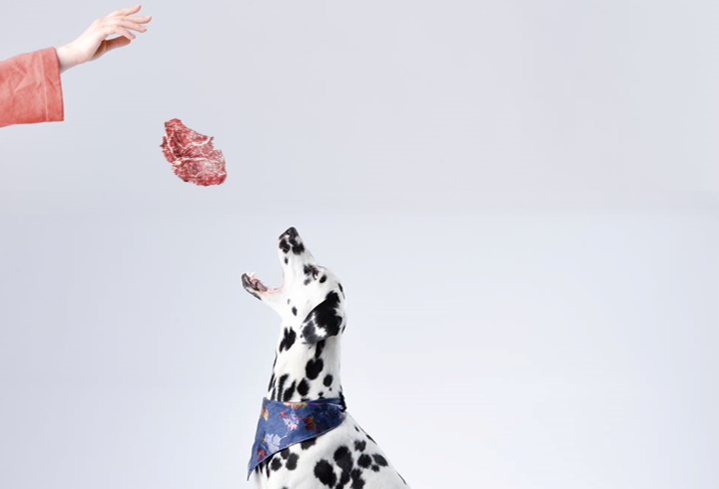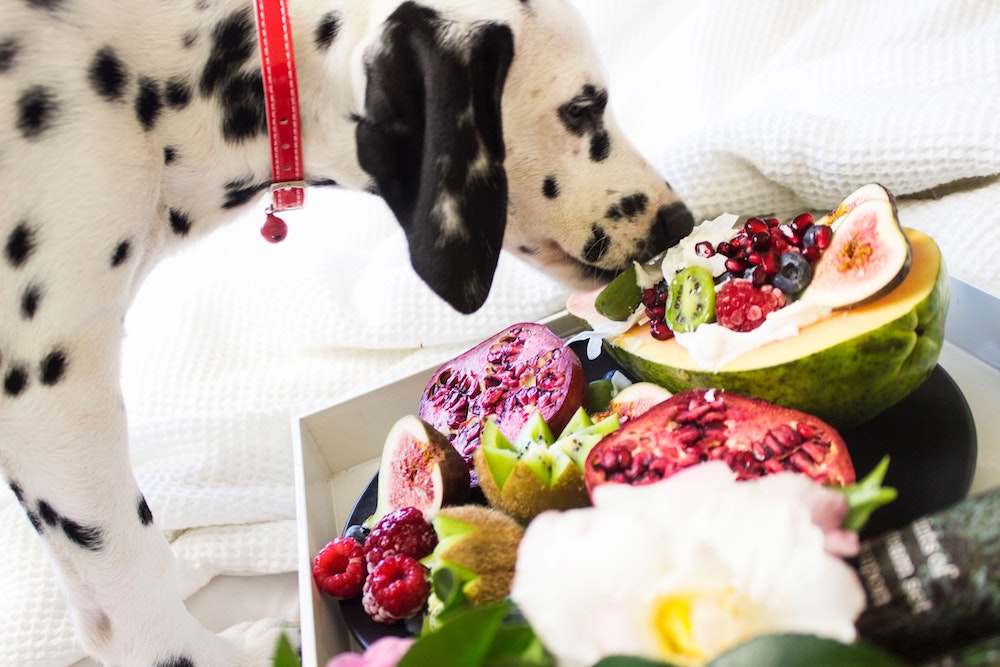Raw food – what is it?
Diets that are based on raw food are becoming increasingly popular among pet owners. Pet owner preferences as well as medical recommendations, have been dictating this preference.
These diets are also known as BARF (Biologically Appropriate Raw Food) or RMBD (Raw Meat-Based Diets). They are composed of raw meat (and/or fish), internal organs (kidney, liver, etc.), bones (intact or grinded) and cartilage and are supplemented with raw eggs and some vegetables. They were designed to mimic what a dog would eat in the wild, hence they are considered a more natural diet.
This type of meals can be prepared at home or acquired at specific shops or online. The most common form of commercial RMBDs are frozen, but freeze-dried products have recently also entered the market.
Pros and Cons
When it comes to diets, we definitely want to check the science supporting them. Nutrition is directly linked to health. That’s why we want to guarantee that the diets we feed our pets are the ones that mean the most health advantages. There are also practical issues to take into account, such as storage conditions and expiration date. We could also focus on financial aspects, but our analysis on the subject didn’t go that far. Mainly because regional differences would make the research too exhaustive or not comprehensive enough. Therefore, we listed only the nutritional and practical aspects of Raw diets that you should know.
Pros
- Better health for your pet’s skin and fur – the BARF diet typically contains high concentration of fatty acids. These allow for better skin and shinier fur.
- Cleaner teeth –chewing raw bones has a mechanical cleaning action on the teeth and promotes the elimination of plaque (or tartar).
- Better palatability – a BARF diet has much more flavour than normal dried foods (kibble). For this reason, raw diets can be a valid option for pets that reject dried foods and/or do not eat the necessary amount to be healthy.
- Better digestibility – given that this type of diet is designed to mimic what our pets would eat in the wild, it is considered to have higher digestibility. People who have adopted this diet for their pets report that they haver more energy, stronger immune system and less complications of the digestive system. Given these reports, this type of diet is sometimes recommended for dogs with allergies or more sensitive digestive systems. The benefits of these diets have not been scientifically proven to current date. These findings derive from empirical observations of isolated cases. Further studies are needed to unequivocally state them as facts.
- Lower faecal volume – given that BARF diet has higher digestibility, more nutrients are absorbed. Consequently, the animal produces a much lower volume of faecal matter (you scoop less poop!). The content in fibre is also lower in this type of diet, which also contributes to lower faecal volume.
- Lower odour intensity – pet owners that opt for raw diets report that their pets’ smell is less intense regarding both the breath and the faeces.
Cons
- Unbalanced diet – a study done on 200 home prepared diets reported that 95% of them lacked at least one essential nutrient and 83.5% had multiple nutritional deficiencies. Without the input of an animal nutrition expert, it is hard to formulate a diet that meets ALL the animal’s nutritional needs. The main nutritional deficiencies found were lack of calcium and phosphorus (which can lead to bone fractures and teeth problems), lack of potassium and zinc and vitamin D excess (which can be detrimental, specially to puppies). However, there is no need to stress if your pet is already on a raw diet! The negative effects of nutrient deficiency are usually seen on the long term, so you still on time to prevent them. Talk to an animal nutrition specialist to tailor your dog’s diet to its needs.
- Risk of infections – the scientific evidence that raw meat caries parasites and bacteria responsible for pet illness is vast. Some of these can be passed on from pets to humans. Raw meat and internal organs that you buy at the supermarket can be easily contaminated at the slaughter house. They carry high levels of bacteria such as salmonella or coli, amongst others. Many of these have the potential to cause gastroenteritis (on both you and your pet), accompanied by vomit and/or diarrhoea. Several studies that have investigated the effects of raw food diets on pets. These studies confirmed that these pets shed more pathogens, some of which are resistant to antibiotics. This can become a public health issue. Therefore, it becomes essential to be aware of the risks linked to raw diets. Ensuring that you have high quality food sources, correct handling and conservation of these products is essential to guarantee a good health for all involved (pets and owners).
- Risk of digestive problems – although the presence of bones in BARF diets is important (source of calcium and mechanic effect on plaque) they can also be the source of some other problems. Due to their hardiness they can cause teeth fractures while chewing. Once they enter the digestive system they can cause blockage of the digestive tract. Swallowing small pieces of bone may cause sores in the mouth and/or inside the digestive organs. In more severe cases, internal perforations may occur, which may lead to the death of the animal.
Things you should consider if you choose to feed your pets raw food
The increasing demand for this type of diets demands we create awareness about the potential risks and how to minimize them. So, here are some things you should consider:
- Due to the potential risk of infection, raw feeding is not recommended for animals that undergoing chemotherapy or have diseases that affect the immune system.
- Pet owners that are prone to infection or in contact with people at higher risk of infection (young children, the elderly, immunosuppressed patients, patients undergoing chemotherapy, etc.) should be aware of the increased risks of infection associated to raw food. Take extra care with storage and handling of raw meat. Given the increased risk of infection, the use of BARF diets is not recommended in these cases.
- Meat should be frozen at -20 ° C for at least 3 days (to kill parasites) and should remain frozen until used. This process does not kill bacteria and they can be present and alive, even after freezing. After thawing, meat should not be frozen again.
- Due to its high protein content, raw food is not recommended for animals with hepatic and/or renal insufficiency (pets with this medical condition have more difficulty metabolising proteins).
- Given their high content in fatty acids, raw diets that are not formulated by experts are not recommended for animals with pancreatitis or diabetes. These pets need very specific formulations which are difficult to obtain from a home-made diet.
- Special caution is required when feeding very young pets with raw diets. An incorrect calcium and phosphorus ratio can cause bone anomalities and growth problems.
- Pets on a raw diet should get periodic examinations and veterinary checkups to ensure that their diet is nutritionally balanced and that there are no deficiencies that need to be addressed. As stated, special attention should be paid to young animals and animals with chronic diseases.
- If you want to adopt a natural home-made diet for your dog, get advice from an animal nutrition specialist. They can help you develop a plan that fits your pet’s needs. Moreover, they can inform you about the risks of raw ingredients and how to minimize them. Following a balanced raw diet requires effort and a lot of knowledge from pet owners. Excessive sloppiness and oversimplification can have dangerous consequences for both the pets and even the humans living with them, in some cases.
In sum, feeding your pet a BARF diet has many advantages and disadvantages. Raw food may not be the best option for all dogs, nor for all owners. Choosing a raw diet is a decision that must be made responsibly, after doing your own research and learning as much as you can on the subject.
It is up to you, as an informed owner, to make the best decision for your pet and for everyone. Is your pet on a raw diet? Let us know all about your experience in the comments.
As always, you can count on PETABLE to keep all your pet’s diet info (and recipes) in one place. The App is free (for iOS and Android) with no ads to clutter your experience.




Leave a Comment